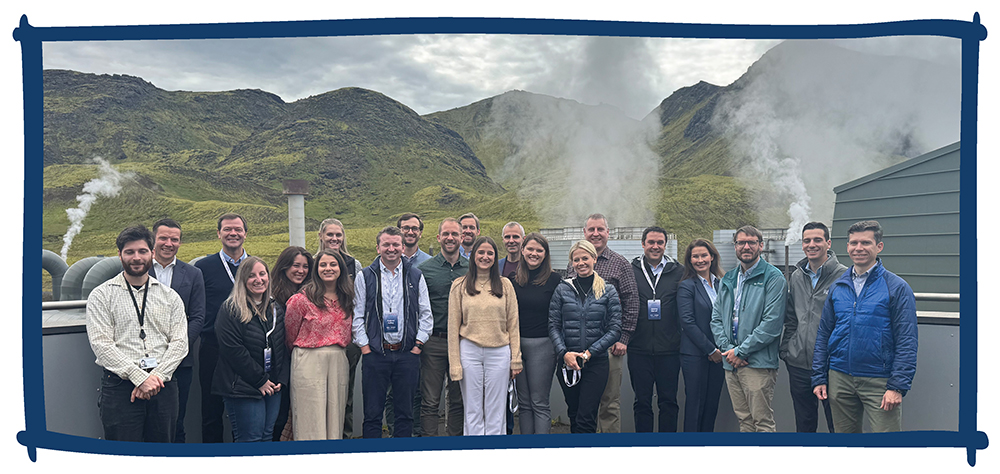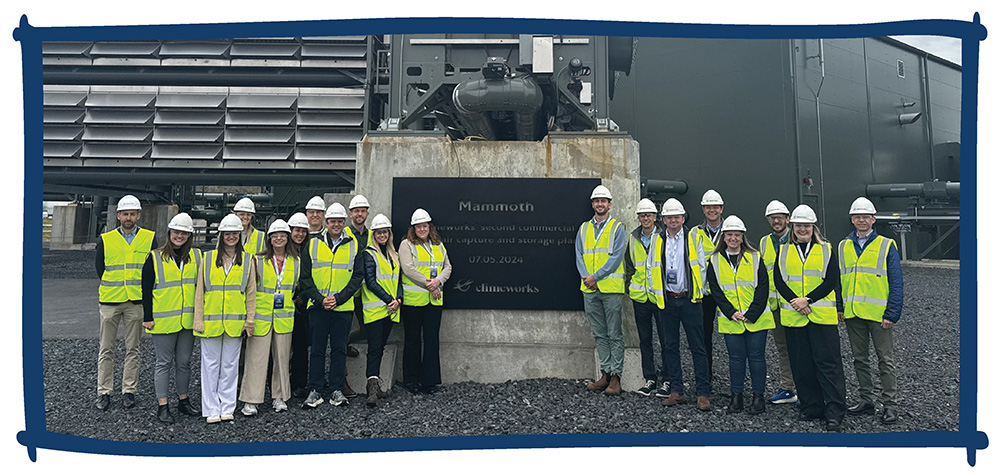Posted on August 14, 2025 by Hillary O’Brien and Matthew Mailloux
Energy security is a key factor in securing any nation’s economy, and countries like Iceland are taking it to the next level. In under a century, Iceland went from one of the European Union’s poorest economies to one of the wealthiest by utilizing what was already under its feet: an abundance of easily accessible energy, in the form of geothermal and hydropower resources.

L-R: ON Power Representative, Ólafur Elínarson, Luke Bolar, Amanda Sollazzo, Hillary O’Brien, Hali Gruber, Dillyn Carpenter, Andrew Kelley, Ryan Mowrey, Adam Stewart, Kári Valgeirsson, Lucy Sadler, Kiddi Haflidason, Ayla Neumeyer, Alexandra Slocum, Ken Klukowski, Jeremy Harrell, Sara Lind Guðbergsdóttir, Andy Zach, Matt Mailloux, Andrew Fishbein
Iceland has some of the shallowest geologic heat reservoirs in the world and a landmass that is more than 10 percent glaciers. ClearPath’s educational series, the Clean Energy Innovation Academy, explored Iceland’s unique clean energy infrastructure with Congressional staff, learning about real energy projects and cutting-edge innovations. We traveled with 10 U.S. Senate staff to study Iceland’s grid, powered by 70% hydropower and 30% geothermal energy. Many of Iceland’s geothermal plants are co-located with industrial parks and facilities, a successful model many U.S. energy developers are interested in to power emerging manufacturing facilities or data centers. The educational visit included:

Climeworks’ Mammoth facility, the world’s largest Direct Air Capture (DAC) facility designed to capture up to 36,000 tons of CO₂ a year.
In the 1930s, Iceland made a change from importing oil and coal to meet its electricity and home-heating needs to embracing its own geologic resources by building out geothermal and hydropower capacity. This strategic shift delivered lower energy costs for consumers, highlighting the immense value of harnessing domestically abundant natural resources. They credit low-cost energy for their economic growth. In the same way, the U.S. can continue to advance and achieve global energy leadership, by investing in drilling technology and next-generation power generation.

The U.S. energy landscape currently features a diverse mix, with significant contributions from natural gas and coal, alongside a growing share from geothermal. According to the U.S. Energy Information Administration (EIA), currently, the U.S. has 4 Gigawatts of geothermal electricity plants in operation, making it the world leader in installed geothermal power capacity. While this is roughly a quarter of the worldwide geothermal capacity, it’s less than 1 percent of our grid. As energy producers and customers look to grow capacity, the geothermal industry is successfully adapting technologies pioneered by the oil & gas industry to unlock previously inaccessible geothermal power resources in the U.S.
This existing capacity, combined with our vast untapped potential, provides opportunities for the U.S. to meet rising energy demand. With U.S. electricity demand projected to surge by 35-50% by 2040—the equivalent of adding three Texas-sized grids—the U.S. must pursue an energy strategy that leverages every reliable, baseload power source available. While Iceland operates a nearly 100% renewable grid, the success of that grid is due to the 100% baseload, 24/7 power characteristics of geothermal and hydropower sources. That works for a small nation of approximately 350 thousand citizens. The U.S. – with a population of 350 million – cannot replicate this formula exactly, but we can continue to learn how to utilize all natural resources, like geothermal and hydropower, but also fossil energy and critical mineral resources to meet our growing energy needs and secure America’s future.
The insights gained from Iceland’s proactive approach to harnessing its resources, streamlining processes, and fostering innovation are a look at what’s to come for the U.S. as we seek to meet surging energy demands, diversify our grid, and cement our leadership in critical technologies.
